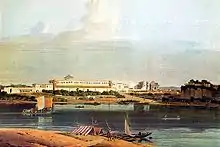Shuja-ud-Daula
Shuja-ud-Daula (b. 19 January 1732 – d. 26 January 1775) was the Subedar[1] and Nawab of Oudh and the Vizier of Delhi from 5 October 1754 to 26 January 1775.[2]
Shuja-ud-Daula | |
|---|---|
| Nawab Wazir of Oudh Nawab Wazir al-Mamalik Wazir ul-Hindustan Subedar of Kashmir, Agra & Oudh Khan Bahadur Asad Jang Arsh Manzil | |
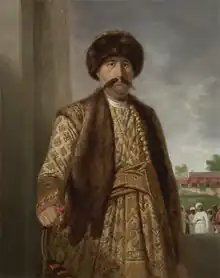 | |
| 3rd Subedar Nawab of Oudh | |
| Reign | 1754 – 26 January 1775 |
| Predecessor | Safdar Jang |
| Successor | Asaf-ud-Daulah |
| Full name | Jalal-ud-din Haider Abul Mansur Khan Shuja-ud-Daula |
| Native name | شجاع الدولہ |
| Born | 19 January 1732 Mansion of Dara Shikoh, Delhi, Mughal Empire |
| Died | 26 January 1775 (aged 43) Faizabad, Oudh State (present-day Uttar Pradesh, India) |
| Buried | Gulab Bari, Faizabad |
| Noble family | Nishapuri Branch of the Kara Koyunlu |
| Spouse(s) | Begum Amanat-uz Zahra Bano "Bahu Begum" |
| Issue | Asaf-ud-Daulah Saadat Ali Khan II |
| Father | Safdar Jang |
| Mother | Sadh-ruh-nissa |
| Military career | |
| Allegiance | |
| Service/ | Nawab of Oudh |
| Rank | Grand Vizier, Subadar, Nawab |
| Battles/wars | Mughal-Maratha Wars Third Battle of Panipat Bengal War Battle of Buxar |
Early life
Shuja-ud-Daula was the son of the Mughal Grand Vizier Safdarjung chosen by Ahmad Shah Bahadur. Unlike his father Shuja-ud-Daula was known from an early age for his abilities to synthesize his subordinates, this skill would eventually cause him to emerge as the chosen Grand Vizier by Shah Alam II.
Shuja-ud-Daula was a giant man.[3][4]
Shuja-ud-Daula is also known to have assisted the Alivardi Khan on various occasions when the territories of the Nawab of Bengal, were being ravaged by Raghoji I Bhonsle and his Marathas. Thus Shuja-ud-Daula is known to have been a very respected figure among the servicemen of Alivardi Khan.
Nawab of Awadh
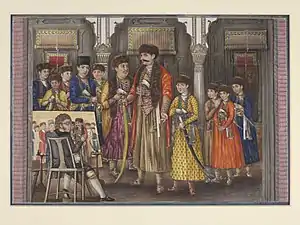
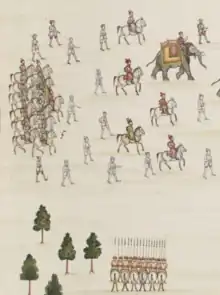
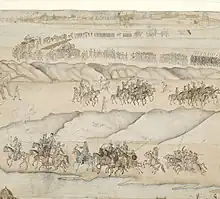
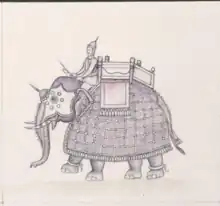
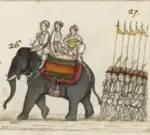
After the death of his father the Mughal Grand Vizier Safdarjung in the year 1753, Shuja-ud-Daula was recognized as the next Nawab by the Mughal Emperor Ahmad Shah Bahadur.
Shuja-ud-Daula despised Imad-ul-Mulk, an ally of the Marathas of the Maratha Empire whose regime emerged after the Battle of Sikandarabad with the support of the Sadashivrao Bhau. Imad-ul-Mulk blinded Ahmad Shah Bahadur and placed Alamgir II on the Mughal imperial throne. Alamgir II and his son Prince Ali Gauhar, were often persecuted by Imad-ul-Mulk because they refused to abandon their peaceful terms with Ahmad Shah Durrani, they also demanded the resignation of Imad-ul-Mulk mainly due to his relations with the Marathas.[5]
Shuja-ud-Daulah's household cavalry was composed of the Sheikhzadi,[6] much of whom belonged to the Qidwai clan, who claimed descent from the Bani Israil.[7] Clan-groups such as the Sayyids of Bilgram, Kara-Manikpur, Sheikhs of Kakori, and the Sayyids of Barha served as court officers and soldiers.[8] The most vigilant of Shuja-ud-Daulah's commander, Naval Rai's troops were his contingent of the Barah Sayyids, while the Bilgramis were of the same stock.[9][10] These clans had not taken any profession other than a soldier or an officer.[11] Shuja-ud-Daulah's father had maintained a contingent of 20,000 "Mughal" cavalry, who were mainly Hindustanis, many who were chiefly from the Jadibal district in Kashmir, who had imitated the Qizilbash in dress and spoke the Persian language.[12][13] The state also saw a large migration of Kashmiri Shi'as to the Shi'a kingdom of Awadh, both to escape persecution and to secure courtly patronage.[14] This was especially the case with men from the district of Jadibal in Kashmir, who were all Shias, who looked to the state as the sword-arm of the Shi'as in India.
Grand Vizier of the Mughal Empire
Prince Ali Gauhar fled from Delhi when he realized a conspiracy that would eventually lead to the murder of the Mughal Emperor Alamgir II. Shuja-ud-Daula welcomed and protected Prince Ali Gauhar, who then declared himself Shah Alam II and officially recognized Shuja-ud-Daula as the Grand Vizier of the Mughal Empire. Together they challenged the usurper Shah Jahan III, who was placed on the Mughal imperial throne by Sadashivrao Bhau and his forces, which plundered much of the Mughal Empire.
Shah Alam II was then advised to lead an expedition that would attempt to retake the eastern regions of the Mughal Empire from Mir Jafar who was supported by the British East India Company. While Shuja-ud-Daula, Najib-ul-Daula and Mirza Jawan Bakht allied themselves with Ahmad Shah Durrani and assisted his forces during the Second Battle of Sikandarabad in the year 1760 and later led a Mughal Army of 43,000 during the Third Battle of Panipat.[15]
Third Battle of Panipat
After escaping from Delhi due to the murder of his father the Mughal Emperor Alamgir II, the young Prince Ali Gauhar was well received by Shuja-ud-Daula. The Nawab of Awadh and the newly appointed Mughal Grand Vizier Shuja-ud-Daula assured Prince Ali Gauhar that he and Najib-ud-Daula would initiate a struggle that would overthrow the Maratha Empire if Prince Ali Gauhar would lead what remained of the Mughal Army against the expanding British East India Company in Bengal.[16]
Shuja's decision about whom to join as an ally in the Third Battle of Panipat was one of the decisive factors that determined the outcome of the war as lack of food due to the Afghans cutting the supply lines of Marathas was one of the reasons that the Marathas could not sustain the day-long battle. Their forces were weak due to starvation and were also fighting facing the sun.
Shuja was not very sure about whose side should he take before the Third Battle of Panipat. The Marathas were still further south then and it would have taken them considerable time to reach Shuja's province. In spite of this, his mother was of the opinion that he should join the Marathas as they had helped his father previously on numerous occasions. However, in the end, Shuja decided to join Ahmad Shah Durrani.
As the chosen Grand Vizier of the Mughal Empire, Shuja-ud-Daula commanded a sizeable army of Mughal Sepoy, who cut off the supplies of the Marathas and even defeated them in pitched confrontations during the Third Battle of Panipat and dispatched the Maratha leader Sadashivrao Bhau.
Abdali wrote to Shuja-ud-Daulah:
"It is now incontestably known that the addressee is a native of those parts, but that forsaking the conversation and manners of his native land , he has incorporated himself with the inhabitants of Hindustan. Whatever has come to pass, is altogether right. Whatever has been has been; the future will, by the favour of God, be fortunate.[17]
Battle of Buxar
Shuja is also known for his role in the Battle of Buxar, a battle that was no less definite in Indian history. He along with the forces of Mughal emperor Shah Alam II & Mir Qasim ruler of Bengal were defeated by the British forces in one of the key battles in the history of British East India company.
Allahabad Treaty
He again fought the British with the help of Marathas at Kara Jahanabad and was defeated. On 16 August 1765 AD he signed the Treaty of Allahabad, which said that Kora and Allahabad district would go to Company and the Company would get 5 million rupees from Awadh.[18] The British would be allowed free trade in Awadh and would help each other in case of war with other powers, which was a very shrewd political move by the Company.[19]
To pay for the protection of British forces and assistance in war, Awadh gave up first the fort of Chunar, then districts of Benaras, Ghazipur and finally Allahabad.[20]
Death and burial

Shuja-ud-Daula died on 26 January 1775 in Faizabad, the then capital of Awadh, and was buried in the same city. His burial place is a tomb and known as Gulab Bari (Rose Garden).
Personal life
Shuja-ud-Daula's Turkic and Iranian Persian Twelver Shia Muslim royal family ruling the Oudh (Awadh) state in India obtained their eunuchs (khwajasarais) through subduing Hindu kings rebellions. Jawahir Ali was a eunuch of Oudh state who was born a Hindu. The Rajas of Khairabad rebelled since they refused to pay taxes to the Twelver Shia district administrator Nawab Muhammad Ali Khan so Nawab Muhammad Ali defeated the Hindus in battle The castrated Hindu boys were converted to Twelver Shia Islam and given Muslim names after being enslaved and then educated. The Twelver Shia Turkic Nawab of Oudh Shuja-ud-Daula (a descendant of the Turkic Twelver Shia Qara Qoyunlu dynasty through his father Safdar Jang) made Nawab Muhammad Ali Khan give his eunuchs including Jawahir Ali to him.[21][22] Jawahir Ali (Joahir Ali) served as nazir eunuch to Bahu Begum (Bahu Begam, Bahoo Begum or Buhoo Begum) (Begum Amanat-uz Zahra Bano), the Iranian Persian wife of the Turkic Twelver Shia ruler of Oudh, Shuja-ud-Daula.[23] Bahu Begum owned multiple eunuchs, all of them of Indian Hindu background. One of them was born a eunuch with defective genital and sold to the Nawab by his family, Darab Ali Khan and he was a general agent of Bahu Begam after Jawahir Ali.[24] Jawahir Ali was the first general agent of Bahu Begam.[25]
Bahu Begam's estates were managed by Javahir 'Ali Khan. The Twelver Shia cleric Mawlavi Muhammad Munir who came to Faizabad and was there during a riot in 1779 between Sufi pirs and physicians against Twelver Shia clerics. Muhammad Munir was paid a stipend and backed up by Javahir Ali. Javahir Ali sent soldiers to support the Twelver scholars against the physicians. The Twelver Shia Usuli ulama were also supported by Javahir Ali when they implemented Friday prayers 7 years after the riots. Javahir paid 20 people to make people attend the 5 mandatory prayers and Friday prayer during the winter and rainy season.[26] Bahu Begum was of Persian Iranian descent. The British East India Company under Warren Hastings tortured the eunuchs Bahar Ali and Jawahir Ali after they arrested Bahu Begum in 1781 in order to force them to give their treasure over.[27]
Jawahir Ali Khan ordered 2 fellow eunuchs belonging to Bahu Begum, Sa'adat and Basharat to assist the Qadi (Qazi) at Ali Beg Khan mosque.[28][29] Due to cold weather, the eunuch minister Darab Ali Khan tried to stop Bahu Begam from reciting Fatiha at Imam Husain's tazia during Muharram but she went regardless and got a fever and cold.[30]
Bahu Begum only allowed Jawahir to enter when she was on her Sedan Chair speaking before British East India Company representative Mr. Lumsden in Lucknow. Darab Ali Khan came from the Salone district, Rusulabad.[31] Jawahir was interred in an imambarah made out of wood after he died in 1799 in Faizabad.[32] Bahu Begum had another favourite eunuch, Tehsin Ali Khan who died on 27 August 1818. He constructed a mosque and owned a Serai.[33] Bahu Begum's name was Amanat-uz Zahra and her eunuch Jawahar Ali Khan built an Imambara in Faizabad.[34] Bahu Begam was the younger sister of Mirza Muhammad[35]
As there is a full account given of Jawahir 'Ali Ķbán in connection with Faizábád, there is no need to speak of him here. Having filled the office of the Nazárat on earth for thirty-four years after the death of Nusrat 'Ali ķhán, he was summoned in 1214 A.H. [1799 A.D.), to superintend the huris of Firdaus, and hastened. to Paradise. Then the lucrative appointments which he had vacated were conferred on Muhammad Dáráb. Ali Ķbán. Although Jawahir . 'Ali Khán had thrice the dignity and opulence of his father,* for his authority extended from the mountain of Butwal on the north to the banks of the Ganges on the south, and he had more than 10,000 horse and foot, and had personal property greater than all the other eunuchs of Faizábád had been able to collect in their whole lives, yet he was never known to utter an arrogant or haughty word, and never assumed any manner or a form of speech which savoured of pride or arrogance. As he had evinced from his early boyhood a taste for literature, he was constantly engaged in reading, and when any literary discussion took place, he used to leave the most urgent business to go and share its advantages. In his early years he was fond of Arabic, and becoming proficient in etymology, syntax, and logic, he entered on the study of Şadra; but owing to his tours and journeys, which he had to make to Lucknow each year and sometimes to the mountain of Butwal, he was unable to make further progress.
He was an able expositor of the ambiguities of Persian poetry. Enigmas and riddles were solved in gatherings around him. Above all, he was especially fond of historical works. He read from beginning to end the Sháhnáma, Hamla-i-Haidarí, the Masnavís of Jalálu'ddín Rúmi, Ma'ariju'nnabuwat, Rauzatu'ssafa, Habibu'ssiyar, Shahjabánnáma, Akbarnáma, Taimúrnáma, Táriķh Farishta, and every other book on which he could lay his hands. The duty of reading these aloud to him was imposed on me. He used to listen to them from sunset until midnight. I heard many narratives and tales while thus privileged with the enjoyment of his society. He always sought the company of scholars, poets, and men of science. He is dead and gone.
* The relation of an old eunuch to a younger one as guru and chelá (priest and novice) is often referred to in this work. When a eunuch adopted another they were spoken of as father and son. This is the relation here alluded to, Jawábir 'Ali being looked on as the adopted son of Nusrat 'Ali, whom he succeeded. Muhammad Faiz Bakhsh, "Memoirs of Delhi and Faizábád: Being a Translation of the Táríḳh Farahbaḳhsh of Muhammad Faiz Baḳhsh from the Original Persian, Volume 1", pages iv-v.[36]
Yusuf Ali Khan and Ambar Ali Khan were 2 other eunuch boys who were raised with Jawahir Ali Khan.[37] Ambar Ali Khan was taken prisoner in the same battle as Jawahir Ali Khan when the Twelver Shia Commissioner Muhammad Ali Khan defeated the Hindu Rajputs of Khairabad (Sitapur) and castrated the Hindu boys.[38] Jawahir Ali Khan used white clothing for Mewatis, black clothing for irregulars and livery in mango green for household troops (Sahib Khanis) when he ordered his servants and soldiers to parade in Lucknow while he was administrator.[39] Jawahir Ali patronized intellectuals and culture as well as engaging in horsemanship and archery practice every day. He did not wear ornate, expensive or elaborate clothing and did not do extravagant grooming, since as a high ranking eunuch (khwajasarai) his mistress did not need to flaunt her wealth through him.[40] Jawahir Ali Khan cone had 1,000 servants shout "Din, Din" while raising banners and wearing white robes after taking off their black robes. One of his officials was Akhund Ahmad. Jawahir Ali had a dispute with his mistress Bahu Begum when he was blocking a road once and she sent a eunuch to tell him to stop it.[41]
In popular culture
- In the 1994 Hindi TV series The Great Maratha, Shuja's character was portrayed by Benjamin Gilani.
- In the 2019 Bollywood film Panipat, Shuja-ud-Daula is portrayed by Kunal Kapoor.
References
- Bhatia, O. P. Singh (1968). History of India, from 1707 to 1856. Surjeet Book Depot.
- Princely States of India
- Dalrymple, William (2019). The Anarchy. United Kingdom: Bloomsbury Publishing. ISBN 978-1-5266-1850-4.
- Journal of the Asiatic Society of Bengal. Bishop's College Press. 1879.
- Srivastava, Ashirbadi Lal (1945). Shuja-ud-daulah. S.N. Sarkar. Retrieved 2 August 2020.
- Pradeep Barua (2005). The state at war in South Asia. p. 73. ISBN 0803213441.
- Amaresh Misra (1998). Lucknow, Fire of Grace:The Story of Its Revolution, Renaissance and the Aftermath. HarperCollins Publishers India. ISBN 9788172232887.
- C.A. Bayly (2012). Rulers_Townsmen_and_Bazaars.
- Journal of the Asiatic Society of Bengal. Asiatic Society (Calcutta, India); Asiatic Society (Calcutta, India). 1832.
- Henry Dodwell, Sir Richard Burn, Sir Wolseley Haig (1957). The Cambridge History of IndiaVolume 4. Pennsylvania State University.
{{cite book}}: CS1 maint: multiple names: authors list (link) - Surya Narain Singh. Mittal Publications. 2003. p. 9.
- Sarkar, Jadunath (1964). Fall Of The Mughal Empire Vol. 1. digitallibraryindia; JaiGyan. p. 254.
- Srivastava, Ashirbadi Lal (1933). textsThe First Two Nawabs Of Oudh (a Critical Study Based On Original Sources) Approved For The Degree Of Ph. D. In The University Fo Lucknow In 1932.
- Hakim Sameer Hamdani (2022). Shi'ism in Kashmir:A History of Sunni-Shia Rivalry and Reconciliation.
- Mohan, Surendra (1997). Awadh Under the Nawabs: Politics, Culture, and Communal Relations, 1722-1856. Manohar Publishers & Distributors. ISBN 978-81-7304-203-4.
- Cotton, James Sutherland; Burn, Sir Richard; Meyer, Sir William Stevenson (1908). Imperial Gazetteer of India: Provincial Series. Superintendent of Government Printing.
Shah Alam ii an shuja-ud-daula.
- Calendar of Persian Correspondence: Being Letters, Referring Mainly to Affairs in Bengal, which Passed Between Some of the Company's Servants and Indian Rulers and Notables. By India. Imperial Record Department. 1914.
- Wikisource: Text of Allahabad Treaty
- HISTORY OF AWADH (Oudh) a princely State of India by Hameed Akhtar Siddiqui
- Shuja-ud-daula (1754–1775)
- Hinchy, Jessica (2015). "Enslaved childhoods in eighteenth-century Awadh". South Asian History and Culture. 6 (3: Childhoods in India: Contemporary and Historical Perspectives): 380–400. doi:10.1080/19472498.2015.1030874. S2CID 145412277.
- Bowen, Zazie; Hinchy, Jessica, eds. (2020). Children and Knowledge: Contemporary and Historical Perspectives from India. Routledge South Asian History and Culture Series (reprint ed.). Routledge. ISBN 978-1000740417.
- Chatterjee, Indrani (July 1996). Slavery and the Household in Bengal, 1770 - 1880 (PDF) (PhD thesis). University of London. p. 63.
- Bakhsh, Muhammad Faiz; Hoey, William (2005). Qureshi, Hamid Afaq (ed.). Memoirs of Faizabad, Being a Translation of the "Tarikh-i-Farahbakhsh" of Muhammad Faiz Bakhsh: 1782-1818. Part 2 of Memoirs of Faizabad, Being a Translation of the "Tarikh-i-Farahbakhsh" of Muhammad Faiz Bakhsh. New Royal Book Company. p. 218. ISBN 8185936927.
Out of regard for Zainu'labdin and in remembrance of Bahar Ali Khan's kindness to me , I went to Jawahir Ali Khan and interceded and pleaded until I ... She bought a Brahman boy from his father and mother in year of famine and brought him up as her son . ... The castrators lifted him , carried him off , castrated him and sold him to the Nawab , who made him over to Shuja'u'ddaulah . The latter entrusted him for education and board to Khushnazr Ali Khan , who was a very old eunuch .
- Hinchy, Jessica Bridgette (January 2013). Power, Perversion and Panic: Eunuchs, Colonialism and Modernity in North India (PDF) (}hD thesis). The Australian National University. pp. 63, 64, 65.
- Cole, J. R. I. (1988). Roots of North Indian Shi'ism in Iran and Iraq : Religion and State in Awadh, 1722-1859. Berkeley: University of California Press. pp. 57, 58.
- Khan, Vijaya (August 1983). "Glimpses into the life and times of the Begums of Avadh". the India Magazine of her people and culture. Vol. 3, no. 9.
- Bakhsh, Muhammad Faiz; Hoey, William (2004). Qureshi, Hamid Afaq (ed.). Memoirs of Faizabad, Being a Translation of the "Tarikh-i-Farahbakhsh" of Muhammad Faiz Bakhsh: 1722-1781. Part 1 of Memoirs of Faizabad, Being a Translation of the "Tarikh-i-Farahbakhsh" of Muhammad Faiz Bakhsh. New Royal Book Company. p. 65. ISBN 8189267019.
The Qazi came and took his seat at Ali Beg Khan's mosque . Basharat and Sa'adat , two of the Bahu Begum's eunuchs , attended at the mosque by Jawahir Ali Khan's order to support the Qazi . The Qazi sent a verbal order to Bani Khanam ...
- Qidwai, Ikramuddin (1 April 1994). "Nawwab Bani Khanam". Journal of the Pakistan Historical Society. 42 (2): 115–119.
- Indian Culture, Volume 1. Indian Research Institute. 1934. p. 633.
In this connection an account of the death of his royal consort Bahu Begam who outlived him by 41 years may , in fitness of things , be recorded here . ... This year she prepared to go as usual but Darab Ali Khan , her eunuch minister , tried to prevent her on account of the fear of a ... She was borne with great respect and ceremony to the Jawahir Bagh on the shoulders of the nobles of Faizabad ; around ...
- Abdul Ali, A. F. M. The last will and testament of Bahu Begum. pp. 6, 7, 8.
- Keshani, Hussein. The Architecture of Ritual: Eighteenth-century Lucknow and the Making of the Great Imambarah Complex, a Forgotten World Monument (PDF) (PhD thesis).
- "Tehsin ki Masjid". LUCKNOW Society.
- Trivedi, Madhu K (1977). Cultural history of the kingdom of awadh (PDF) (PhD thesis). Aligarh Muslim University.
- Srivastava, Ashirbadi Lal (1961). Shuja-ud-Daulah (PDF) (D.Litt thesis). Vol. I (2nd Revised and corrected ed.). p. 5.
- Bakhsh, Muhammad Faiz; Hoey, William (1888). Memoirs of Delhi and Faizábád: Being a Translation of the Táríḳh Farahbaḳhsh of Muhammad Faiz Baḳhsh from the Original Persian, Volume 1. Government Press, North-western Provinces and Oudh. pp. iv, v.
- Bowen, Zazie; Hinchy, Jessica, eds. (2020). Children and Knowledge: Contemporary and Historical Perspectives from India. Routledge South Asian History and Culture Series (reprint ed.). Routledge. ISBN 978-1000740417.
- Bhasin, Rakesh (2018). Dastan-e-Awadh: A Momentous Journey from Faizabad to Lucknow. Notion Press. ISBN 978-1642498820.
- BAYLY, C. A. (1988). "CHAPTER 10 The origins of swadeshi (home industry): cloth and Indian society, 1700-1930". In Appadurai, Arjun (ed.). The Social Life of Things: Commodities in Cultural Perspective. ACLS Humanities E-Book, Cambridge studies in social and cultural anthropology (illustrated, reprint ed.). Cambridge University Press. p. 304. ISBN 0521357268.
- Hinchy, Jessica; Miescher, Stephan F.; Mitchell, Michele; Shibusawa, Naoko (2015). "PART I Labour 1 The Sexual Politics of Imperial Expansion: Eunuchs and Indirect Colonial Rule in Mid-Nineteenth-Century North India". Gender, Imperialism and Global Exchanges. Gender and History Special Issues (reprint ed.). John Wiley & Sons. p. 30. ISBN 978-1119052197.
- Pakistan Historical Society (1994). Journal of the Pakistan Historical Society, Volume 42. Pakistan Historical Society. pp. 116, 117, 118.
Salih , leaving the service of Jawahir ' Ali Khan joined the service of Bani Khānam . He entreated that his wife Nūrjahān ... and it was not expedient to stay in . She again spoke to the Bahū Begum who sent a eunuch to Jawāhir ' Ali Khān saying ... Jawahir ' Ali Khān was so much in the heat of passion that he became reckless , and forgetting the relations of master and servant , he returned no answer ...
Further reading
- Shuja-ud-Daulah – Vol. I, II (1754–1765) by Ashirbadi Lal Srivastava
